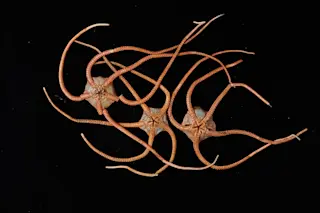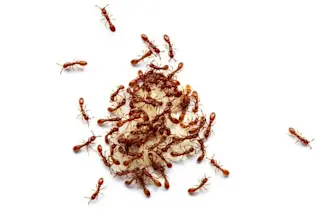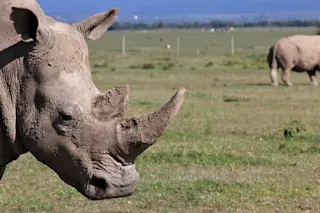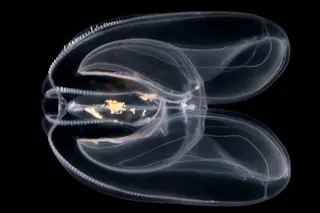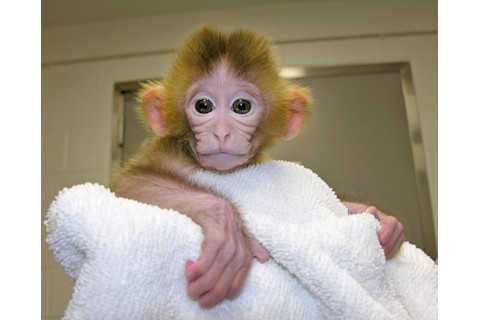
The aptly named Chimero is one of the world's first chimeric monkeys. | Jim Newman/OHSU
The world’s first chimeric monkeys were created in a laboratory last year, and they offer surprising new insights into embryonic stem cell therapy: One reason for often-poor treatment outcomes may be that we’re using embryos that are, strangely, just too old.
Researchers have long been able to create chimeras—offspring with more than two parents—in rodents like mice by combining embryos so tiny they consist of only eight cells in all. At this early stage of their development, embryos are made of pluripotent stem cells, each of which can give rise to many, though not all, tissue types.
Previous attempts to do the same in monkeys, however, have failed—a disappointment because monkeys are more similar than mice to humans, and thus likely a better harbinger of how stem cell treatments will fare in people.
“Stem cells function far differently in mice than in monkeys,” says biologist Shoukhrat Mitalipov, a senior scientist in the Division of Reproductive and Developmental Sciences at Oregon National Primate Research Center and lead author of the monkey study. “If we’re going to bring stem cells to the human clinic, we need to know exactly how those stem cells will work. In mice, you can inject pluripotent stem cells from a black mouse into the embryo of an albino mouse [in the womb of a mother mouse] and they will get along well, and you’ll end up with a black-and-white-spotted mouse chimera. In the monkey, when we tried injecting 20 or 30 laboratory-cultured pluripotent stem cells, nothing happened. The stem cells seemed to disappear; maybe they died.”
That led Mitalipov to try a different approach, using even younger embryos made of a whisper of four totipotent stem cells—cells that are even more flexible, able to develop into any cell type. The result: three male rhesus macaques—twins Roku and Hex, and the singleton, Chimero.
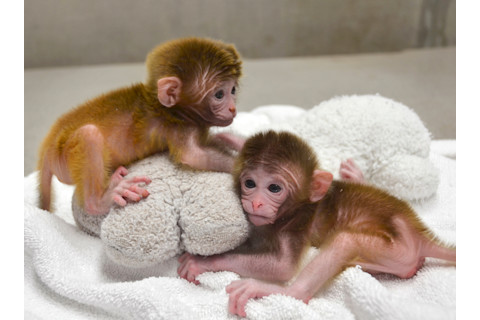
Twins Roku and Hex, along with Chimero, may represent a better approach to stem cell technology. | Jim Newman/OHSU
The finding could fundamentally change how we look at human stem cell tech: If chimeric monkeys require totipotent cells before they can come into being, it stands to reason that human embryonic stem cell therapy might also require totipotent stem cells to render cures. Indeed, the find suggests that testing human therapies on mice and other mammalian species may have sent us down the garden path.
The Chimeric Advantage
The ability to create chimera from stem cells not only in mice but in other animals, including primates, could prove to be a major advance in biomedical science. In a 2009 study, University of Georgia at Athens cloning expert Steve Stice created 29 chimeric piglets by injecting pluripotent stem cells into pig embryos before implanting them into a surrogate womb.
Although it wasn’t the first time chimeric pigs were created, it was the first time they came about using cloned pluripotent cells. And because pigs are genetically closer to humans than mice are, success in creating chimeric pigs from stem cells offered renewed hope that the technology could lead to better pharmaceutical testing or stem cell therapies.
“If we’re going to bring stem cells to the human clinic, we need to know exactly how those stem cells will work."
But the most significant part of these finds, says bioethicist Jason Robert of Arizona State University, is that research on rodents (or pigs) may not be directly applicable to humans. Even rhesus macaques, he says, “are not the ideal nonhuman primate to study, since they are not as closely related to us as chimpanzees. We need to ask if we’d learn more if we studied other animals—more expensive animals that are closer to humans. If our ultimate goal is to take human cells and transplant them into human subjects, we want to know ahead of time that they will behave and integrate well.”
Mitalipov couldn’t agree more. “Stem cell therapies hold great promise,” he says, from possible treatments for brain disease to heart disease and age-related disorders. “No drug could restore functional tissue the way that stem cells could.” But given the difficulty of achieving monkey chimeras from pluripotent cells, Mitalipov thinks we might need to derive an entirely new stem cell class for regenerative medicine in humans: the all-powerful totipotent cells.
Meanwhile, the monkeys will be weaned and raised to adulthood. “We will see if these three monkeys can have normal offspring. We will want to see if these chimeras persist through the generations,” Mitalipov says.
THE HUMAN FACTOR
It’s worth considering what a human chimera might look like, but any such experiment would, of course, run up against ethical barriers. In 1998, Dutch embryologist Jacques Cohen, director at Reprogenetics LLC in New Jersey, inadvertently created human chimeras.
He and his team removed cytoplasm from the eggs of healthy mothers and injected it into the eggs of women having trouble getting pregnant. That cytoplasm contained DNA from the cells’ mitochondria—self-contained structures inside our cells that carry their own genome. Cohen and his team then fertilized the eggs in the laboratory with sperm and implanted them in the womb.
The resulting embryos—and live births—contained mitochondrial DNA from both egg donors along with regular, nuclear DNA from the mother and father. Just how normal these children, and their children, will turn out to be—or whether the extra contribution might confer some advantage—nobody knows.
Cohen and colleagues have since abandoned such experiments, given the outcry that followed their initial results. “All chimera research poses interesting ethical dilemmas. The key question is to balance the value of the research with its controversial nature,” says bioethicist Jason Robert.



